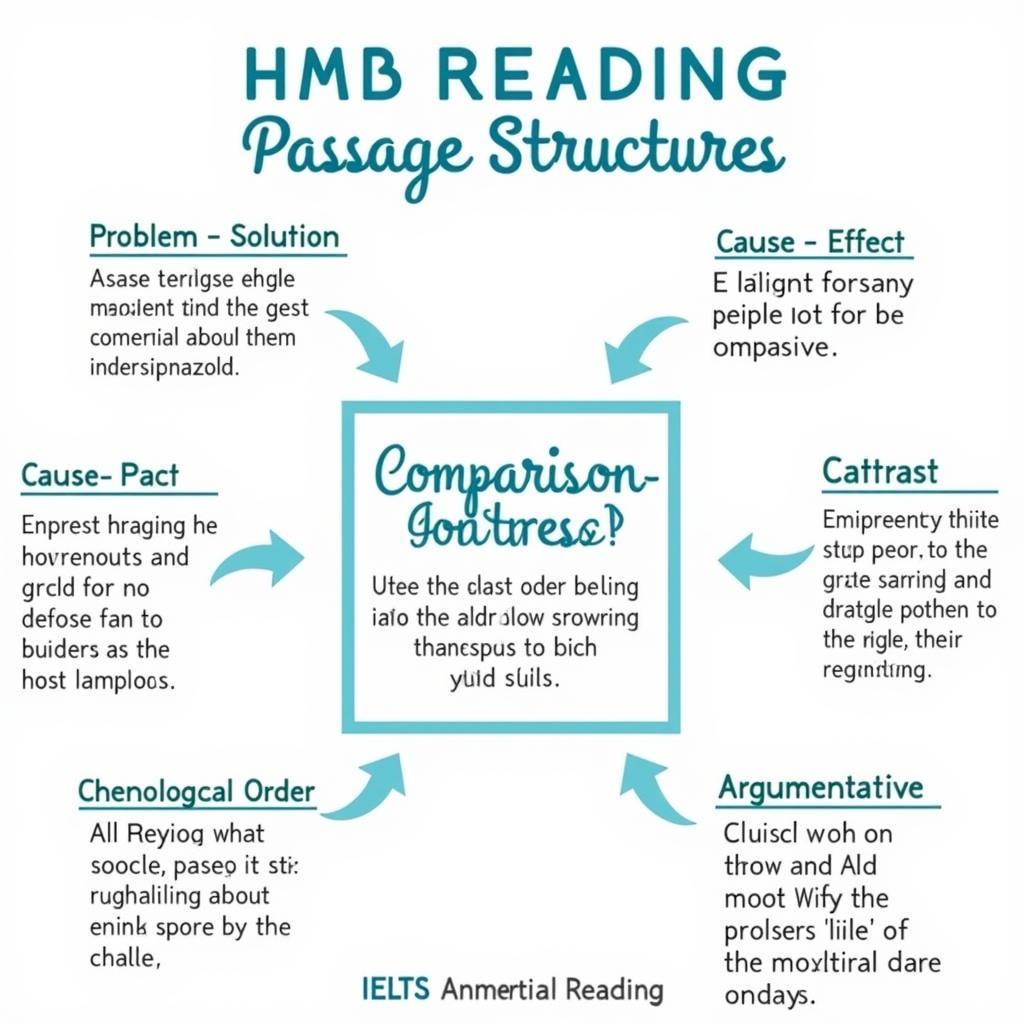Giỏ hàng hiện tại chưa có sản phẩm nào!

Mastering IELTS Reading Structure
Understanding the structure of IELTS Reading passages is crucial for achieving a high band score. This knowledge enables you to quickly locate information, answer questions effectively, and ultimately conquer the reading section. This comprehensive guide will delve into the intricacies of IELTS reading structure, equipping you with the necessary skills to navigate various passage types and maximize your score.
Decoding Different IELTS Reading Passage Structures
IELTS Reading passages come in various formats, each with its own unique structure. Recognizing these structures is the first step towards efficient comprehension. Common structures include:
- Problem-Solution: This structure presents a problem and then offers one or more solutions. Identifying the problem and the proposed solutions is key to answering related questions.
- Cause-Effect: This structure explores the relationship between causes and their effects. Understanding this chain of events is essential for answering questions related to consequences and reasons.
- Comparison-Contrast: This structure compares and contrasts two or more things, highlighting their similarities and differences. Paying attention to these comparative elements is crucial for answering questions related to distinguishing features.
- Chronological Order: This structure presents information in a time-based sequence, often used in historical or biographical passages. Understanding the timeline of events is vital for answering questions about specific periods or stages.
- Argumentative: This structure presents a specific viewpoint or argument, supported by evidence and reasoning. Recognizing the main argument and the supporting points is key to answering questions about the author’s perspective.
 Phân tích cấu trúc bài đọc IELTS
Phân tích cấu trúc bài đọc IELTS
Recognizing the underlying structure of a passage helps you predict the location of information and answer questions more efficiently.
Identifying Key Structural Elements
Beyond the overall structure, identifying specific elements within each passage further enhances your comprehension. These elements include:
- Headings and Subheadings: These provide a roadmap of the passage’s content, highlighting main ideas and their relationships.
- Topic Sentences: The first sentence of each paragraph usually introduces the main idea of that paragraph.
- Keywords and Phrases: These words and phrases signal important information related to the main ideas and supporting details.
- Transition Words: Words like “however,” “furthermore,” and “in contrast” indicate shifts in thought and relationships between ideas.
- Examples and Illustrations: These provide concrete examples to support the main points and clarify complex concepts.
By focusing on these structural elements, you can quickly grasp the main points and navigate the passage with greater ease.
Applying Structure to Answer Questions Effectively
Understanding the structure not only aids comprehension but also plays a vital role in answering questions accurately. By mapping the questions to the corresponding sections of the passage, you can quickly locate the relevant information. For example, if a question asks about the “advantages of a particular method,” you can quickly locate the section discussing those advantages based on your understanding of the passage structure.
mau piailug ocean navigator ielts
Furthermore, recognizing the question type helps you predict the kind of information you need to find. For instance, “True/False/Not Given” questions require you to evaluate the information presented in the passage against the statements provided. Knowing the passage structure helps you quickly locate the relevant information to make these evaluations.
Practice Makes Perfect: Tips for Improving Your Understanding of IELTS Reading Structure
- Analyze Sample Passages: Regularly analyze sample passages, identifying the overall structure and key elements.
- Time Yourself: Practice reading passages under timed conditions to improve your speed and efficiency.
- Focus on Keywords: Pay attention to keywords and phrases that signal important information and relationships between ideas.
- ielts simulation test 8 This will familiarize you with the exam format and improve your ability to handle different passage structures.
- ielts reading skills strategies Learning effective reading strategies can significantly improve your comprehension and speed.
 Luyện tập hiểu cấu trúc bài đọc IELTS
Luyện tập hiểu cấu trúc bài đọc IELTS
By implementing these tips and dedicating time to practice, you can significantly improve your understanding of IELTS reading structure and boost your overall band score.
In conclusion, mastering IELTS reading structure is essential for success in the reading section. By understanding different passage structures, identifying key elements, and applying this knowledge to answer questions effectively, you can unlock your full potential and achieve your desired score. Remember to practice consistently and utilize available resources to enhance your skills. IELTS reading structure is a key to unlocking a higher band score.
FAQ
- What are the common types of IELTS reading passage structures?
- How can understanding the structure help me answer questions?
- What are some key structural elements to look for in a passage?
- How can I improve my understanding of IELTS reading structure?
- Are there any resources available to help me practice analyzing passage structures?
- What are some tips for managing time effectively during the reading section?
- How can I identify the main argument in an argumentative passage?
Mô tả các tình huống thường gặp câu hỏi.
Thí sinh thường gặp khó khăn trong việc xác định cấu trúc bài đọc, đặc biệt là khi gặp các bài đọc dài và phức tạp. Việc không nắm rõ cấu trúc dẫn đến việc khó khăn trong việc xác định thông tin chính, thông tin phụ và mối liên hệ giữa chúng, gây khó khăn cho việc trả lời câu hỏi.